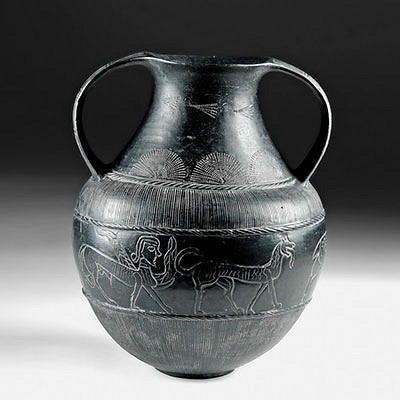Stunning / Large Chancay Painted Textile
Lot 87
About Seller
Artemis Fine Arts
686 S Taylor Ave, Ste 106
Louisville, CO 80027
United States
Selling antiquities, ancient and ethnographic art online since 1993, Artemis Gallery specializes in Classical Antiquities (Egyptian, Greek, Roman, Near Eastern), Asian, Pre-Columbian, African / Tribal / Oceanographic art. Our extensive inventory includes pottery, stone, metal, wood, glass and textil...Read more
Estimate:
$4,000 - $6,000
Absentee vs Live bid
Two ways to bid:
- Leave a max absentee bid and the platform will bid on your behalf up to your maximum bid during the live auction.
- Bid live during the auction and your bids will be submitted real-time to the auctioneer.
Bid Increments
| Price | Bid Increment |
|---|---|
| $0 | $25 |
| $300 | $50 |
| $1,000 | $100 |
| $2,000 | $250 |
| $5,000 | $500 |
| $10,000 | $1,000 |
| $20,000 | $2,500 |
| $50,000 | $5,000 |
| $100,000 | $10,000 |
| $200,000 | $20,000 |
About Auction
By Artemis Fine Arts
Sep 17, 2020
Set Reminder
2020-09-17 10:00:00
2020-09-17 10:00:00
America/New_York
Bidsquare
Bidsquare : CLEARANCE - Ancient, Pre-Columbian, Ethno Art
https://www.bidsquare.com/auctions/artemis-gallery/clearance---ancient-pre-columbian-ethno-art-5605
End-of-Summer Clearance sale featuring discounted pricing on antiquities from Egypt, Greece, Italy, and the Near East...plus Viking, Asian, Pre-Columbian, Tribal, Russian Icons, Spanish Colonial, Fine Art, more! Starting prices have been reduced up to 65% from original auction prices. Artemis Fine Arts info@artemisgallery.com
End-of-Summer Clearance sale featuring discounted pricing on antiquities from Egypt, Greece, Italy, and the Near East...plus Viking, Asian, Pre-Columbian, Tribal, Russian Icons, Spanish Colonial, Fine Art, more! Starting prices have been reduced up to 65% from original auction prices. Artemis Fine Arts info@artemisgallery.com
- Lot Description
**Originally Listed At $2500**
Pre-Columbian, Chancay, modern day Peru, ca. 1300 to 1470 CE. A bright, rectangular textile decorated with twelve rectangular panels, each with a bright background. They alternate between single standing anthropomorphic figures facing forward and a series of monkeys and birds. Each anthropomorphic figure wears a different, dramatic headdress, including one with snakes hanging off its sides! Along the top edge is a repeated pattern of crab-like creatures. Brilliant colors make this piece's preservation all the more remarkable - pale sky blue, deep red, green, and ocher yellow create a vibrant visual field. Size of panel: 21.25" W x 35" H (54 cm x 88.9 cm); size of frame: 28.75" W x 42.5" H (73 cm x 108 cm)
The people of the early cultures in the Andes buried their dead in bundles with woven textiles, sometimes wearing clothing like this loincloth. These often have repetitive, almost fractal patterns, often placed inside of frames, and with color sequences designed to make the viewer look across them diagonally. The red color is probably from cochineal, a bright red insect, while the yellow and black colors would have come from various plants. The dry, cold climate of the Andes preserved these textiles. As time went on, their designs changed - from ca. 1300 CE onward, motifs began to emphasize anthropomorphic figures rather than geometric abstractions. The iconography of these textiles remains unclear, but some scholars have advanced the theory that figures shown face on (like the ones on this textile) are gods.
Provenance: ex-private southern Florida, USA collection, acquired in the 1980s
All items legal to buy/sell under U.S. Statute covering cultural patrimony Code 2600, CHAPTER 14, and are guaranteed to be as described or your money back.
A Certificate of Authenticity will accompany all winning bids.
We ship worldwide and handle all shipping in-house for your convenience.
#150053Edges are slightly frayed. Loss to one corner and in one area of the bottom and near the upper center (as shown). Some staining and discoloration; however, the motifs are well-preserved.Condition
- Shipping Info
-
All shipping is handled in-house for your convenience. Your invoice from Artemis Gallery will include shipping calculation instructions. If in doubt, please inquire BEFORE bidding for estimated shipping costs for individual items.
-
- Buyer's Premium



 EUR
EUR CAD
CAD AUD
AUD GBP
GBP MXN
MXN HKD
HKD CNY
CNY MYR
MYR SEK
SEK SGD
SGD CHF
CHF THB
THB













